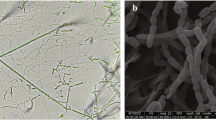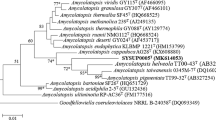Abstract
A novel actinobacterium, designated as strain WRP15-2T, was isolated from rhizosphere soil of rice plant (Oryza rufipogon). The strain was Gram-stain-positive, aerobic, and non-motile. Phylogenetic analysis based on the 16S rRNA gene sequences showed that strain WRP15-2T fell into the genus Saccharopolyspora. The strain shared the highest 16S rRNA gene sequence similarity with the type strains Saccharopolyspora kobensis JCM 9109T (99.1%), Saccharopolyspora indica VRC122T (98.9%), and Saccharopolyspora antimicrobica DSM 45119T (98.7%). However, the digital DNA-DNA hybridization and average nucleotide identity values among these strains confirmed that the microorganism represented a novel member of the genus Saccharopolyspora. Chemotaxonomic data revealed that strain WRP15-2T possessed MK-9(H4) as the predominant menaquinone. It contained meso-diaminopimelic acid as the diagnostic diaminopimelic acid and arabinose, galactose, and ribose as predominant whole-cell sugars. The detected phospholipids were dominated by phosphatidylethanolamine, hydroxy-phosphatidylethanolamine, phosphatidylmethylethanolamine, hydroxy-phosphatidylmethylethanolamine, and phosphatidylcholine. The predominant cellular fatty acids were iso-C16:0, C16:0, and iso-C15:0. The G + C content of the genomic DNA was 69.5%. Based on these genotypic and phenotypic data, it is supported that strain WRP15-2T represents a novel species of the genus Saccharopolyspora, for which the name Saccharopolyspora oryzae sp. nov. is proposed. The type strain is WRP15-2T ( = TBRC 15728T = NBRC 115560T).
This is a preview of subscription content, access via your institution
Access options
Subscribe to this journal
Receive 12 print issues and online access
$259.00 per year
only $21.58 per issue
Buy this article
- Purchase on Springer Link
- Instant access to full article PDF
Prices may be subject to local taxes which are calculated during checkout



Similar content being viewed by others
References
Lacey J, Goodfellow M. A novel actinomycete from sugar-cane bagasse: Saccharopolyspora hirsuta gen. et sp. nov. Microbiol. 1975;88:75–85.
Warwick S, Bowen T, McVeigh H, Embley TM. A phylogenetic analysis of the family Pseudonocardiaceae and the genera Actinokineospora and Saccharothrix with 16S rRNA sequences and a proposal to combine the genera Amycolata and Pseudonocardia in an emended genus Pseudonocardia. Int J Syst Evol Microbiol. 1994;44:293–9.
Kämpfer P. Genus Saccharopolyspora. In: Goodfellow M, Kämpfer P, Busse H-J, Trujillo M, Suzuki K, editors. Bergey’s Manual of Systematics Bacteriology. Vol 5, Springer; 2012. p. 1396–1414.
Parte AC, Carbasse JS, Meier-Kolthoff JP, Reimer LC, Göker M. List of Prokaryotic names with Standing in Nomenclature (LPSN) moves to the DSMZ. Int J Syst Evol Microbiol. 2020;70:5607.
Yang Z-W, Salam N, Asem MD, Fang B-Z, Lan L, et al. Saccharopolyspora deserti sp. nov., a novel halotolerant actinobacterium isolated from a desert. Int J Syst Evol Microbiol. 2018;68:860–4.
Kim SB, Goodfellow M. Saccharopolyspora. In: Whitman WB, editor. Bergey’s Manual of Systematics of Archaea and Bacteria. John Wiley & Sons, Inc; 2015. p. 1–30.
Saygin H, Ay H, Guven K, Inan-Bektas K, Cetin D, et al. Saccharopolyspora karakumensis sp. nov., Saccharopolyspora elongata sp. nov., Saccharopolyspora aridisoli sp. nov., Saccharopolyspora terrae sp. nov. and their biotechnological potential revealed by genome analysis. Syst Appl Microbiol. 2021;44:126270.
Pham JV, Yilma MA, Feliz A, Majid MT, Maffetone N, et al. A review of the microbial production of bioactive natural products and biologics. Front Microbiol. 2019;10:1404.
Huang P, Molina J, Flowers JM, Rubinstein S, Jackson SA, et al. Phylogeography of Asian wild rice, Oryza rufipogon: a genome‐wide view. Mol Ecol. 2012;21:4593–604.
Pikovskaya R. Mobilization of phosphorus in soil in connection with vital activity of some microbial species. Mikrobiol. 1948;17:362–70.
Shirling ET, Gottlieb D. Methods for characterization of Streptomyces species. Int J Bacteriol. 1966;16:313–40.
Cross T, Maciver AM, Lacey J. The thermophilic actinomycetes in mouldy hay: Micropolyspora faeni sp. nov. Microbiol. 1968;50:351–9.
Waksman SA. Studies on the proteolytic enzymes of soil fungi and actinomycetes. J Bacteriol. 1918;3:509–30.
Waksman SA, Henrici AT. The nomenclature and classification of the actinomycetes. J Bacteriol. 1943;46:337–41.
Hamaki T, Suzuki M, Fudou R, Jojima Y, Kajiura T, et al. Isolation of novel bacteria and actinomycetes using soil-extract agar medium. J Biosci Bioeng. 2005;99:485–92.
Mundie DA. The NBS/ISCC Color System. http://www.anthus.com/Colors/Cent.html. 1995.
Gordon RE, Barnett DA, Handerhan JE, Pang CH-N. Nocardia coeliaca, Nocardia autotrophica, and the nocardin strain. Int J Syst Evol Microbiol. 1974;24:54–63.
Williams S, Goodfellow M, Alderson G, Wellington E, Sneath P, et al. Numerical classification of Streptomyces and related genera. Microbiol. 1983;129:1743–813.
Smibert RM, Krieg NR. Phenotypic characterization. In: Gerhardt P, Murray RGE, Wood WA, Krieg NR, editors. Methods for General and Molecular Bacteriology. Washington DC: ASM; 1994. p. 607–54.
Gordon RE, Mihm JM. A comparative study of some strains received as nocardiae. J Bacteriol. 1957;73:15–27.
Becker B, Lechevalier M, Lechevalier H. Chemical composition of cell-wall preparations from strains of various form-genera of aerobic actinomycetes. Appl Microbiol. 1965;13:236–43.
Hasegawa T, Takizawa M, Tanida S. A rapid analysis for chemical grouping of aerobic actinomycetes. J Gen Appl Microbiol. 1983;29:319–22.
Staneck JL, Roberts GD. Simplified approach to identification of aerobic actinomycetes by thin-layer chromatography. Appl Microbiol. 1974;28:226–31.
Tomiyasu I. Mycolic acid composition and thermally adaptative changes in Nocardia asteroides. J Bacteriol. 1982;151:828–37.
Minnikin D, Patel P, Alshamaony L, Goodfellow M. Polar lipid composition in the classification of Nocardia and related bacteria. Int J Syst Evol Microbiol. 1977;27:104–17.
Collins M, Pirouz T, Goodfellow M, Minnikin D. Distribution of menaquinones in actinomycetes and corynebacteria. Microbiol. 1977;100:221–30.
Sasser M. Identification of bacteria by gas chromatography of cellular fatty acids. MIDI technical note 101. Newark, DE: MIDI inc; 1990.
Kieser T, Bibb MJ, Buttner MJ, Chater KF, Hopwood DA. Practical Streptomyces Genetics. Norwich: The John Innes Foundation; 2000.
Yoon S-H, Ha S-M, Kwon S, Lim J, Kim Y, et al. Introducing EzBioCloud: a taxonomically united database of 16S rRNA gene sequences and whole-genome assemblies. Int J Syst Evol Microbiol. 2017;67:1613.
Saitou N, Nei M. The neighbor-joining method: a new method for reconstructing phylogenetic trees. Mol Biol Evol. 1987;4:406–25.
Felsenstein J. Evolutionary trees from DNA sequences: a maximum likelihood approach. J Mol Evol. 1981;17:368–76.
Fitch WM. Toward defining the course of evolution: minimum change for a specific tree topology. Syst Biol. 1971;20:406–16.
Tamura K, Stecher G, Kumar S. MEGA11: molecular evolutionary genetics analysis version 11. Mol Biol Evol. 2021;38:3022–7.
Gurevich A, Saveliev V, Vyahhi N, Tesler G. QUAST: quality assessment tool for genome assemblies. J Bioinform. 2013;29:1072–5.
Richter M, Rosselló-Móra R, Oliver Glöckner F, Peplies J. JSpeciesWS: a web server for prokaryotic species circumscription based on pairwise genome comparison. J Bioinform. 2016;32:929–31.
Meier-Kolthoff JP, Auch AF, Klenk H-P, Göker M. Genome sequence-based species delimitation with confidence intervals and improved distance functions. BMC Bioinform. 2013;14:1–14.
Meier-Kolthoff JP, Göker M. TYGS is an automated high-throughput platform for state-of-the-art genome-based taxonomy. Nat Commun. 2019;10:2182.
Overbeek R, Olson R, Pusch GD, Olsen GJ, Davis JJ, et al. The SEED and the Rapid Annotation of microbial genomes using Subsystems Technology (RAST). Nucleic Acids Res. 2014;42:D206–D14.
Blin K, Shaw S, Kloosterman AM, Charlop-Powers Z, Van Wezel GP, et al. antiSMASH 6.0: improving cluster detection and comparison capabilities. Nucleic Acids Res. 2021;49:W29–W35.
Lechevalier MP, De Bievre C, Lechevalier H. Chemotaxonomy of aerobic actinomycetes: phospholipid composition. Biochem Syst Ecol. 1977;5:249–60.
Goris J, Konstantinidis KT, Klappenbach JA, Coenye T, Vandamme P, et al. DNA–DNA hybridization values and their relationship to whole-genome sequence similarities. Int J Syst Evol Microbiol. 2007;57:81–91.
Yoon S-H, Ha S-M, Lim J, Kwon S, Chun J. A large-scale evaluation of algorithms to calculate average nucleotide identity. Antonie van Leeuwenhoek. 2017;110:1281–6.
Lautru S, Gondry M, Genet R, Pernodet J-L. The albonoursin gene cluster of S. noursei: biosynthesis of diketopiperazine metabolites independent of nonribosomal peptide synthetases. Chem Biol. 2002;9:1355–64.
Meier-Kolthoff JP, Göker M. TYGS is an automated high-throughput platform for state-of-the-art genome-based taxonomy. Nat Commun. 2019;10:1–10.
Vaddavalli R, Peddi S, Kothagauni SY, Begum Z, Gaddam B, et al. Saccharopolyspora indica sp. nov., an actinomycete isolated from the rhizosphere of Callistemon citrinus (Curtis). Int J Syst Evol Microbiol. 2014;64:1559–65.
Acknowledgements
This research is funded by Kasetsart University through the Graduate School Fellowship Program to Sirikarn Kammanee. We are grateful to Ms Duangkamon Boonchuay for sample collection. We would also like to thank UGSAS-GU via the “Microbiology Laboratory Station for IC-GU12” at Kasetsart University.
Author information
Authors and Affiliations
Corresponding author
Ethics declarations
Conflict of interest
The authors declare no competing interests.
Additional information
Publisher’s note Springer Nature remains neutral with regard to jurisdictional claims in published maps and institutional affiliations.
Supplementary information
Rights and permissions
Springer Nature or its licensor (e.g. a society or other partner) holds exclusive rights to this article under a publishing agreement with the author(s) or other rightsholder(s); author self-archiving of the accepted manuscript version of this article is solely governed by the terms of such publishing agreement and applicable law.
About this article
Cite this article
Kammanee, S., Muangham, S., Butdee, W. et al. Saccharopolyspora oryzae sp. nov., isolated from rhizosphere soil of the wild rice species Oryza rufipogon. J Antibiot 76, 658–664 (2023). https://doi.org/10.1038/s41429-023-00647-6
Received:
Revised:
Accepted:
Published:
Issue Date:
DOI: https://doi.org/10.1038/s41429-023-00647-6



